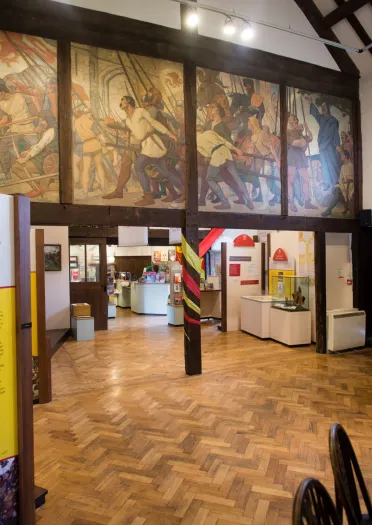The landscape of Mid Wales is famous for its natural beauty and wide-open spaces, but humans have left their mark too. Here are a few things to look out for.
Fabulous forts
Head to Mid Wales and you’ll be following in the footsteps of some of our first ancestors. This is a place full of Iron and Bronze Age hillforts, with landmarks such as Pen Dinas on the on the edge of Aberystwyth. At the top of the hill are the remains of a fort dating back to around 400BC. Take in the panoramic views over the Ceredigion coast from this lofty vantage point and it’s clear why the fort’s former inhabitants chose to build here.
You’ll also find dozens of forts among the hills of the Bannau Brycheiniog (Brecon Beacons) National Park. Make the climb up to the Iron Age Pen-y-Crug or Brecon Gaer Roman Fort, both near Brecon, to peer back into our ancient history.

Enchanting castles
Compared to our prehistoric hillforts, the medieval castles that dot our landscape are new kids on the block (most of them were built only as recently as the 12th century). One of our most atmospheric fortresses is Carreg Cennen at the western edge of Bannau Brycheiniog (Brecon Beacons) National Park. Occupying a clifftop perch overlooking the surrounding countryside, it’s survived any number of battles in its long history. Nowadays it’s a romantic ruin (and a popular spot for marriage proposals) with some of the best views in Wales.
Since its construction in the 12th century Cardigan Castle has seen some dramatic events – including an assault by Vikings in 1138 and Wales’ first Eisteddfod in 1176. If you fancy the chance to live like a king, you can even spend the night in the castle, which was restored and re-opened in 2015.

Ceredigion and Cardigan Bay
The coastline of Ceredigion and Cardigan Bay is brimming with maritime history. During the 19th century the harbour town of Aberaeron was one of the busiest shipping centres on the Welsh coast. Goods like wool, iron and livestock flowed through the harbour, while steam and sail-powered ships were built here in their hundreds. Today, the town’s maritime past is celebrated by the annual Aberaeron Carnival, when the locals build colourful floats and parade them through the streets each August.
Not far from Aberaeron is the pretty little seaside village of Llanon. See how its residents once lived by visiting Llanon Cottage, a traditional two-bedroom house preserved as it would have looked in the 18th and 19th centuries. The village’s other claim to fame is as the birthplace of St David, the patron saint of Wales. It’s actually named after St Non, David’s mother who is believed to have lived here around AD500.

The Vale of Rheidol Railway
Trains played an important part in keeping this area on the move. Ore and timber once travelled on narrow gauge lines such as the Vale of Rheidol Railway. Opening in 1902, its success as an industrial transporter was fairly short-lived, as the closure of local mines and two World Wars saw the line fall into decline. It still managed to soldier on though, and was the last steam-powered railway to be owned by British Rail until privatisation in 1986. Now run by a charitable trust, the railway has been restored to its former glory and is one of the best ways to see the lush green countryside that lies inland from Aberystwyth.

Devil’s Bridge
Ride the Rheidol Railway to the end of the line and you’ll reach Devil’s Bridge, home to a spectacular series of waterfalls that tumble down into a steep wooded ravine. Alongside the natural beauty, watch out for the unusual sight of three bridges stacked on top of each other. Local legend says that lowest, oldest bridge was built by Satan himself. Nearby, you’ll also find heritage attractions like the Hafod Estate, a picture-perfect 200-hectare estate criss-crossed with walks.



Discovering heritage
It's not just outdoor you can explore the history and heritage of the area. There's plenty of social history to be found in the many Mid Wales museums. Ceredigion Museum and Gallery in Aberystwyth shares the fascinating story of the sea-side town and the surprising industrial heritage around the area. The Royal Commission on the Ancient Monuments of Wales and the National Library of Wales are open to the public and are fabulous places to do more research. The Coflein online catalogue is brilliant - you can overlay current maps with tithe maps, search for photographs and records plus explore their online galleries.


The rural market town of Machynlleth is probably better known now for the annual comedy festival, but it was once the capital of Wales. Owain Glyndŵr built his Parliament house here, now home to the Owain Glyndŵr Centre where you can find out more about the fifteenth century 'Prince of Wales'. Keen walkers can follow in the footsteps of Glyndŵr along the long distance Glyndŵr's Way, between Knighton and Welshpool, via Machynlleth.
Nearby Corris was built around the slate industry. You can explore some of the industrial heritage with an expert guide from Corris Mine Explorers or the more child-friendly King Arthur's Labyrinth. The Corris Railway runs steam trains between Maespoeth and Corris and is a lovely way to see the Dulas Valley.



Built alongside the banks of the River Severn, Newtown is an old market town with a rich industrial heritage. The Newtown Textile Museum explores the woollen industry in the area while the Robert Owen Memorial Museum celebrates the locally-born social reformer Robert Owen. Nearby Gregynog Hall & Gardens is thought to date from 1500, with ancient oak trees and beautiful gardens to explore. Castell Dolforwyn is more ancient still. Built between 1273-77 by Llywelyn ap Gruffudd (Llywelyn the Last), the ruins now overlook the Montgomery countryside.
Nearer the border, Welshpool is heritage hotspot. Looking over the town is the magnificent National Trust run Powis Castle, renowned for the stunning gardens surrounding the buildings. Powysland Museum next to the canal tells the story of the area, and you can explore the canal by boat or foot. The Welshpool & Llanfair Light Railway is a delightful steam-hauled trundle through the Mid Wales countryside to the rural town of Llanfair Caereinion.









